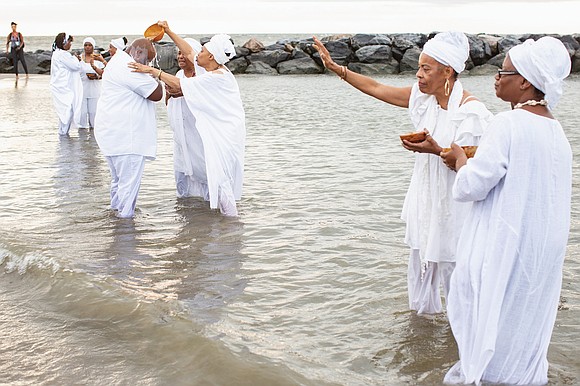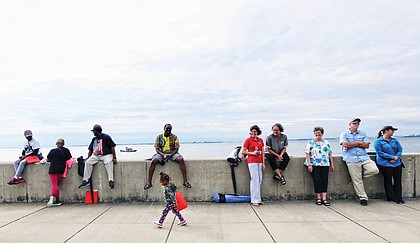Surviving the journey: Thousands of people gather in a weekend of reflection and healing in Hampton to remember, honor the first Africans brought as captives to English North America 400 years ago
Brian Palmer | 8/30/2019, 6 a.m.

As day broke last Saturday, tides of people of all ages and colors flowed down the promenade at Hampton’s Buckroe Beach.
Some were dressed for a day at the shore in shorts and T-shirts, with windbreakers or sweats. Others, all of them black people, were clad in white — gowns over skirts and dresses for many of the women; shirts and loose pants for the men.
The line of people gave their names to two black women sitting at a table, the last step before they would begin the African cleansing ritual and name ceremony for which they had registered long before this day.
A few yards away, three black men in colorful ceremonial robes stood silently on the beach, something they and every black person gathered there would not have been able to do a little more than 50 years ago because Buckroe was, by law, for whites only.
Another robed man, Ancestral Master Drummer Joseph Ngwa from the central African nation of Cameroon, beat his drum to bring together the milling crowd, now in the hundreds. He then blew a horn to signal the pouring of a libation that would summon the ancestors.
Professional photographers and videographers jockeyed for position with observers wielding their cellphone cameras. Then everyone settled in place, encircling the robed chiefs.
Chief Asam Asam Eyong of Cameroon’s Bamoun people led the ritual, pouring liquid from a cow horn onto the sand, then bowing deeply onto a tortoise shell and animal pelt he laid on the ground.
Chief Eyong and the other chiefs then led the assembly in a call and response:
“Africa must rise! Africa must rise again!”
With Mr. Ngwa beating his drum, women dressed in white robes and head wraps, known as the African-American queen mothers from the Institute of Whole Life Healing in Lexington, Ky., led the crowd to the water’s edge.
There, with water from a calabash, pairs of queen mothers anointed the heads of the white- clad men and women who came to them one at a time. One of the queen mothers would gesture, pulling apart her fists as if ripping a cloth.
She was breaking the chains of slavery.
The solemn, yet emotional ceremony at Buckroe Beach was among the most powerful events of the “First African Landing Commemorative Weekend,” four days of speeches, panel discussions, ceremonies and performances marking the 400th anniversary of the 1619 arrival of the first captive Africans in English-occupied North America.
With the exception of Saturday’s daybreak cleansing ceremony at Buckroe Beach and a few others, most events took place at Fort Monroe in Hampton, where “20 and odd Negroes” aboard an English pirate ship, the White Lion, were traded in 1619 for food and provisions at what was then known as Point Comfort.
It, essentially, was the beginning of the slave trade in English North America, a barbaric inhumane practice that would last for centuries, its evil legacy persisting today. By the mid-1800s, more than 12 million Africans had been captured, sold and transported across the Atlantic to the Americas and the Caribbean.
Some who participated in Saturday’s beach ritual beamed, while others stood silent and reflective.
Wendell Shannon of Baltimore sighed and paused when asked about the ceremony’s significance.
“It connects me to the painful experience of the trans-Atlantic slave trade — the bowels of the ships, the jumping off the ships and suicides. Now it’s time for liberation and reconnection to our mother Africa,” Mr. Shannon said.
Jermaine Nelson, a young man also from Maryland, said he was looking for his roots and for a more profound connection to Africa. As part of the ceremony that accompanied the anointing, he received a new name, “Guiawang,” drawn from the Tikar people of Cameroon.
“I’m looking for home,” he said.
Organizer Ada Adagho Brown of the African heritage group Roots to Glory said afterward that it was important the morning was planned and executed by Africans and African-Americans. So much of the schedule didn’t appear to be geared to either group, ostensibly the focus of the weekend.
“I didn’t feel us in here,” Ms. Brown said. “I actually felt that there were two different events. One for them”— white people — “what they want the world to know, what they want the world to see. And one for us.”
The weekend was organized under the flag “American Evolution” by state and federal commemoration commissions, the Fort Monroe Authority, the National Park Service, the City of Hampton and Project 1619, a black-led nonprofit.
But at times, it seemed politicians — many of whom were white people — sought to hijack the big events attended by several thousand people that also featured African drumming and dancing, spoken word and other presentations by youths, a long line of educational exhibits and vendors along the Fort Monroe waterfront and a ceremony where flower petals were dropped into the Chesapeake Bay in remembrance of the first Africans and other ancestors.
Saturday’s main event, the “2019 African Landing Commemorative Ceremony,” featured 17 speakers, while Sunday’s ceremony, “Healing Day,” featured 11 speakers, including Gov. Ralph S. Northam, who used the podium on both days to continue his post-blackface rehabilitation.
Gov. Northam announced Saturday that he has set up a commission to study how the African-American experience is taught in Virginia and a separate commission to examine racial inequity in law. He also announced that sculptor-painter Brian R. Owens, an award-winning artist based in Florida, has been selected after a national search to lead the $500,000 First African Landing public art project at Fort Monroe. Mr. Owens is African-American.
In his address on Saturday, U.S. Sen. Tim Kaine spoke about Oliver W. Hill Sr., the pioneering civil rights attorney from Richmond, who was pivotal in the lawsuit that led to the U.S. Supreme Court’s landmark 1954 decision in Brown v. Board of Education outlawing the “separate but equal” doctrine in public education.
Sen. Kaine, an attorney, said before his speech that he was well aware that slavery in the “New World” didn’t begin in 1619. It started long before in Spanish-occupied North America. But what the English gave the young colony of Virginia, he said, was its legal system — a framework that white male colonists tailored to construct the brutal system of American chattel slavery.
“It wasn’t destined by God. It wasn’t destined by the crown. We had to create it,” Sen. Kaine said.
He then spoke about the Declaration of Independence, which Virginians helped to write. “What does it say about Virginians — Americans — all are created equal? This is like Virginia’s greatest gift to the world, and at the same time the people who were signing that document were creating the architecture of slavery and secession and then Massive Resistance.”
Lt. Gov. Justin E. Fairfax spoke during Saturday’s and Sunday’s ceremony about his family history and the manumission of his great-great- great grandfather, Simon Fairfax, in 1798.
He also recounted the story of 1619 African captives Anthony and Isabella, who gave birth to William Tucker in 1624, the first documented African-American child born in English North America. Many of the Tucker descendants participated in the weekend’s events and also hosted a reflection and commemoration ceremony on Friday morning at the Tucker Family Cemetery, tucked in a residential area of Hampton.
Former Gov. L. Douglas Wilder, the grandson of slaves and the nation’s first African-American elected governor, was noticeably absent from Saturday’s and Sunday’s events at Fort Monroe. He had been invited to serve as an honorary chair of the commemoration, but was openly critical last month, saying his invitation “was only a polite inclusion.”
“I learned that it was more ceremonial than actual in terms of what I was asked to do,” he told the audience on Friday, where he was the main attraction at a luncheon panel at the Hampton Convention Center. The luncheon, “African-American Political Pioneers,” also featured Congressman Robert C. “Bobby” Scott of Newport News and other politicians whose elections were “firsts” in their communities.
Rep. Scott is the first African-American to be elected to Congress from Virginia since the post-Reconstruction-era election of John Mercer Langston. Before his election in 1888, Mr. Langston, an attorney, educator and diplomat, helped create Howard University’s law school and became its first dean. He also had served as the first president of what became Virginia State University.
Although politicians dominated the weekend program, they did not have the last word.
“I came here today to honor you and all of those warriors that came before you, who have literally made the way for all of us,” Chief G. Anne Richardson, a Rappahannock woman and the first woman to lead a Native American tribe in Virginia since the 18th century, said to the largely African-American crowd of several thousand on Sunday, the final day of the commemoration.
The Sunday ceremony followed a symbolic four-minute ringing of bells at Fort Monroe and national parks and churches across the country — one minute for each 100 years of African presence in the nation.
Sunday’s keynote speaker, Georgetown University professor, author, preacher and radio host Dr. Michael Eric Dyson, didn’t mince words in a blistering, irreverent and thought-provoking speech about what black people have faced during the course of 400 years in America.
He started, however, by addressing Gov. Northam’s blackface scandal that rocked Virginia earlier this year.
“I saw the governor. In the back,” Dr. Dyson said with a preacher’s timing. “I wanted to tell him to his face what I had said behind his back. And that is, ‘Ain’t nothing better than a white boy who knows he messed up, who stays in office to fix it up.’ ”
The crowd roared.
He then gave a history lesson, highlighting in 100-year increments the brutalities and injustices inflicted on African-Americans.
“When America says the worst act of terror happened on 9-11, you’re wrong,” he said. It was 1619 and what followed for black people, he said.
Dr. Dyson took on colorism among black people, a damaging legacy of enslavement that he said needs to stop.
“We better realize that we’re all in the same boat. I don’t care how light or dark you are, you still a n- - - - r in America.”
He also went after President Trump, calling him “an orange apparition,” “bigot-in-chief,” and a “white supremacist.”
For all the painful truths he told, Dr. Dyson ended by calling on black people to love ourselves — and to vote.







